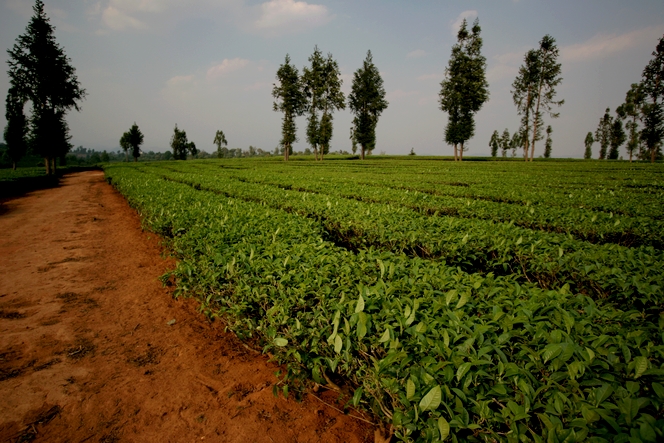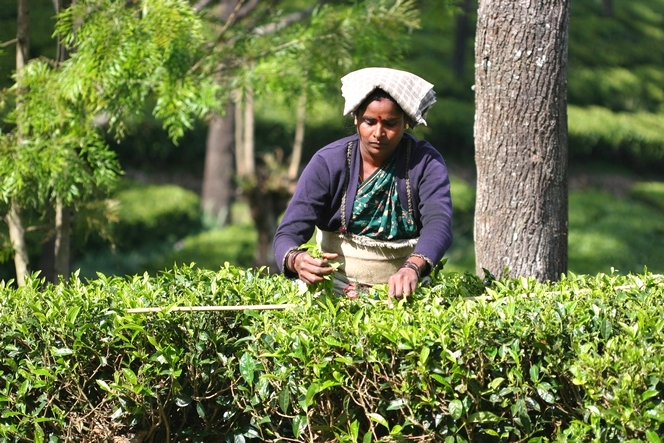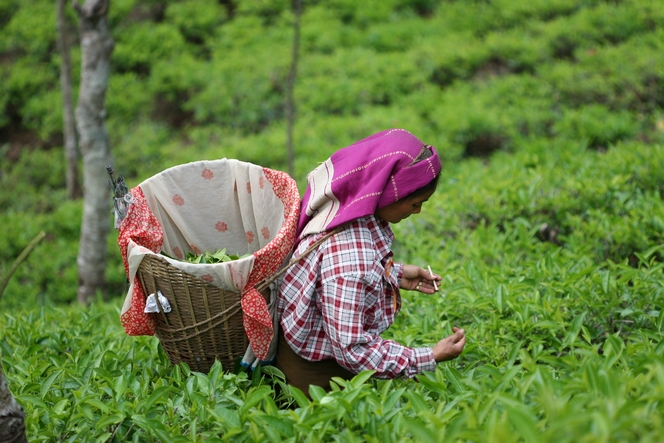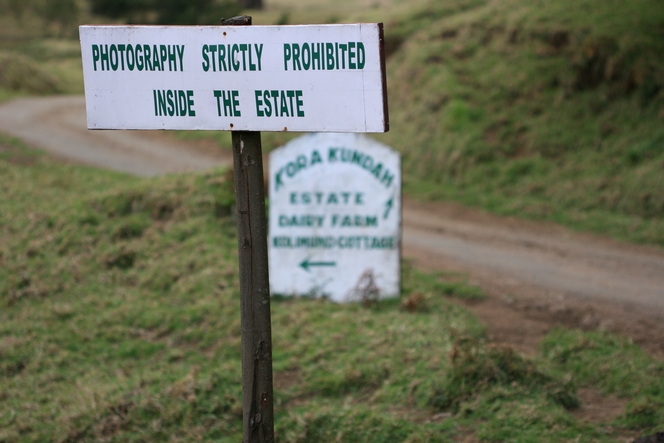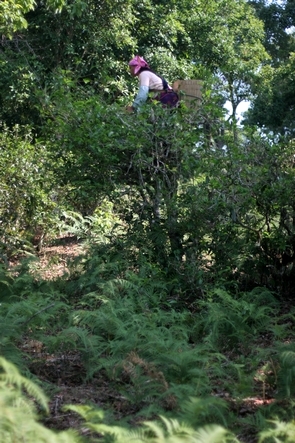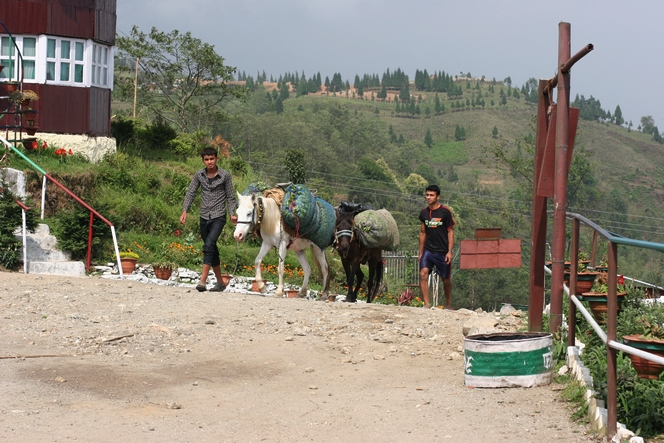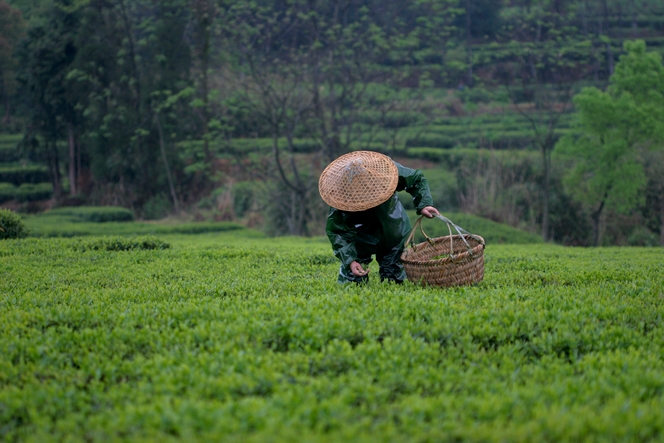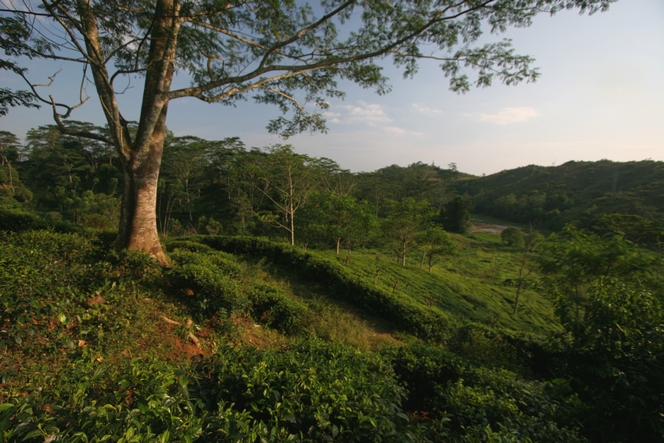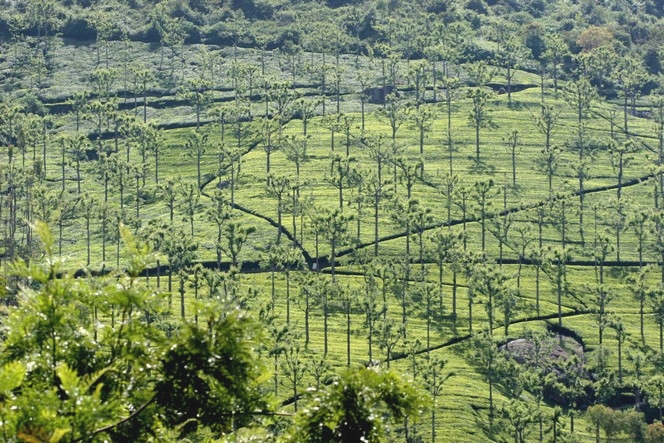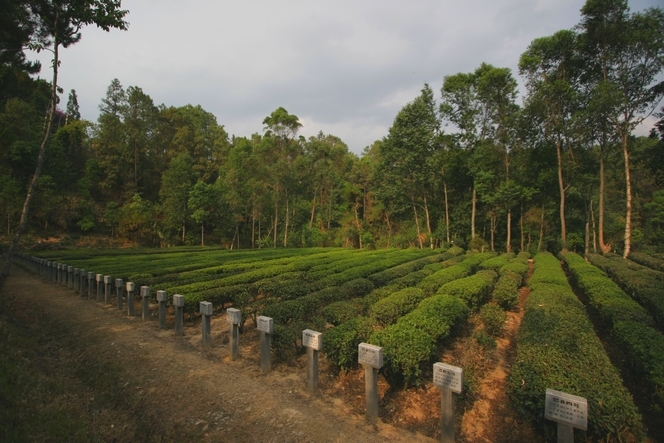Yunnan is known for its red earth, which is highly fertile. Agriculture, like the tea here, is one of the main resources of this region, which borders the Mekong. Thanks to the clement and relatively stable temperatures, teas like the Grand Yunnan Imperial can be harvested all year long with no noticeable difference in quality.
From plant to cup
A clever trick to ensure a quality tea harvest
On some tea plantations, they use a long bamboo stick to ensure a quality harvest. This photo taken in the Nilgiri (India) shows how it is used: the plucker has placed it in front of her and only takes the shoots that extend beyond it. This prevents the plucking of the previous season’s leaves, which are tougher and don’t produce good tea.
Tea pluckers harvest tea leaves with bamboo sticks
When you harvest the tea leaves, you must take great care to pick the right parts. Only the tea bud and the two adjacent leaves give you true quality. Sometimes, to prevent the tea pluckers from taking too much off, they are given a short piece of bamboo. This helps them pick just the right length of shoot and is a reminder of the standards of excellence required (like here at the Namring Tea Estate, Darjeeling, India).
I don’t trust plantations that prohibit taking photos
At some tea plantations, they don’t like you taking photos. Sometimes, like here at Kora Kundah (southern India), there are even signs prohibiting it. I always wonder what this means. What do they have to fear from me taking photos? What is it they don’t want me to see? Most of the time it is simply a statement of ownership, a way of prohibiting trespassing. In reality, at the plantation of Kora Kundah, I know I’m free to go where I like and to photograph whatever I want. It is actually a great tea plantation, producing teas of high quality with organic and fair trade labels.
I don’t trust tea estates that limit their access or prohibit taking photos. At first I always ask why. If the reasons are not convincing, I refuse to trade and politely turn back. One mustn’t generalize, but I notice that this happens in Sri Lanka more than anywhere else.
Harvesting Pu Er, a highly perilous work !
In China, in Yunnan province where they produce Pu Er, tea plants are sometimes left to grow into proper trees. It is thought that the leaves of these “wild” tea plants are better. But this makes harvesting perilous: the pluckers have to climb a ladder into the tree and harvest buds and tea leaves, while remaining balanced on the top. Impressive.
Horses can be a great help to transport tea
In Ilam (Nepal), horses are still used to transport tea leaves. These two young men have walked for two hours to reach the place where the tea is processed, so they can sell their fresh tea leaves. Hanging against the horses’ flanks are sacks weighing around 20 kilos each. They try to avoid making this long journey on a rainy day, otherwise the cargo can get damaged as it begins to ferment.
The tea tree is maintained at a convenient height
Since the tea leaves are picked constantly, like here in the Gao Shan region of China, litteraly meaning “High Mountain”, the tea tree cannot grow any bigger. It is maintained, harvest after harvest, at the most convenient height: not too low, so the task is not made more difficult, and not too high, to stop parasites developing at the base of the plants. The tea trees are kept at between knee and waist height, depending on the region and the climate.
“High grown” and “low grown” teas
In the south of Sri Lanka the altitude is low and the vegetation very dense. The tea plantations, which are small in this region, are surrounded by luxuriant vegetation. The teas produced here are known as “low grown”, unlike the teas grown in the very mountainous centre of the island, called “high grown”. But take note! A low grown tea is not of inferior quality, on the contrary. Because of the greater care taken when processing the tea leaves of low grown plants, they often achieve better prices at the Colombo auctions.
Protecting tea plants from the heat
As I was mentioning it in a previous post, tea requires delicate care. Tea plants appreciate a bit of shade, especially if the sun is strong. In the hottest regions, trees are planted to help the plants and give them some cover, like here in the Nilgiri mountains (India).
Contrarily to Darjeeling and Assam, the tea produced in the region is mainly black crushing-tearing-curling (CTC) tea and harvesting occurs all year round. This straightfoward process applied to low quality leaves makes a tea with little taste, often found in tea bags…
So, not very good teas in this region, but beautiful landscapes, charming little villages (Coonoor, Munnar), gardens growing spices, hills covered with cardamom plantations… An appealing region to say it short.
Cultivar is to tea what grape variety is to wine
All tea plants are members of the Camellia Sinensis species, but there are a great many cultivars, each with their own unique characteristics and qualities. Some are more resistant to the cold, for example, or to certain parasites. Others produce a more abundant crop.
Here, in Feng Qing, near Lincang (China), tea planters breed a wide variety of cultivars in order to experiment with grafting, for example, to produce new hybrid tea plants.
I visited this tea garden last year between two tastings of Pu Er, the main tea found in the region and manufactured from a cultivar called “Da Ye” (big leef).
Moreover, it’s here, near Lingcang, that the old tea and horse exchange road comes by.

